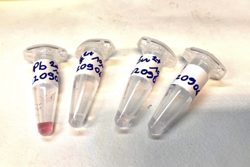The detection of contamination at very low concentration is a major axis of analytical sciences. In this regards DNA is a very exciting material.
In a wide variety of contexts, civil or military, industrial or societal, it is necessary to process a sample in search of contaminating compounds. Whatever the nature of the targeted compounds (bacteria, viruses, cancer cells, toxins, pollutants, pesticides, etc.), a common characteristic is the low level of contamination or the low concentration of the entity sought within the sample. For example, in the case of bacteremia (bacterial infection of the blood), it is necessary to detect one bacterium per milliliter of blood, or in the case of accidental lead contamination of drinking water, it is necessary to be able to measure a few tens of nanomolar lead ions. Thus, a major axis of development of analytical tools and methods is the development of the most sensitive methods possible, whatever the nature of the sample (blood, urine, food matrix, drinking water, environmental sample, etc.).
In the particular case of the detection of biological targets, Polymerase Chain Reaction (PCR) is an extremely efficient method, as the SARS-CoV2 crisis has recently shown. PCR remarkable efficiency is based on the ability of nucleic acids to hybridize to a complementary DNA sequence. Beyond its "natural" hybridization properties, DNA can also be manipulated and used for remarkable "unnatural" properties, such as its ability to bind to a target molecule (aptamers) in a manner similar to an antibody would bind to an antigen, or to catalyze a chemical reaction (DNAzyme) as an enzyme would. These properties make DNA a very exciting material for biosensing purposes. If these functions have their counterpart among proteins, such properties derived from DNA fragments bring remarkable advantages with respect to proteins such as their ability to detect low molecular weight molecules (< 1,000 Da) which are generally not or not very immunogenic, their ease of synthesis and modification (grafting of fluorophores and other functionalities), their stability and better resistance to drying (important for integration in a sensor), their low cost and commercial accessibility, etc.
The M1 internship main objectives are therefore :
- to validate the ability of some nucleic acids (aptamers and DNAzymes) to detect a low molecular weight target (we will target lead ions as a relevant model),
- to assess the specificity of these structures toward lead (and not toward similar metallic cations such as Zinc, Magnesium, Calcium…) and
- to functionalize gold nanoparticles (AuNPs) with DNA strands to play with aggregation-resuspension of AuNPs to set-up an optical biosensor.
This work will be inspired by a publication, and will be devoted to both the concept validation, and DNA-nanostructures grafting on nanoparticles.
The M2 internship will be devoted to the operation of these nanostructures (DNAzymes on AuNPs) grafted on the surface of Surface Plasmon Resonance biochips. The underlying idea is based on the use of this label-free method to improve the limit-of-detection of lead ions. We also plan to combine isothermal amplification methods (easier to operate than PCR) to amplify further the signal induced by DNAzymes combined to both AuNPs and SPR biochips.
This latter strategy, never described so far, could be the basis of a PhD project at the interface between Nanochemistry, Physics, and biomolecule engineering.
This project will be carried out in the
CREAB team of the SyMMES laboratory, under the supervision of Yoann Roupioz (Biochemist, Senior Researcher in Biomolecule engineering for biosensors) and Arnaud Buhot (Theoritical physicist, Senior Researcher in Biomolecule interaction modeling and biosensing data analysis). Our laboratory is equipped with a DNA engineering plate-forme (
BioMADE), several chemistry laboratories, and several bio-safety level 2 laboratories. Our team is used to host students from all over the World in a multi-disciplinary and multi-cultural environment of people passionate about science.
Opened to: student in Master 1 Nanochemistry or Phelma-Biomedical Engineering.
Expected skills: This internship is proposed to any student interested in pluri-disciplinary research, at the interface between nano-chemistry, physics, and biomolecule engineering. A background in organic chemistry, and/or some experience in the handling of nucleic acids or proteins would be appreciated. We do expect this project to be pursued as a PhD project.

